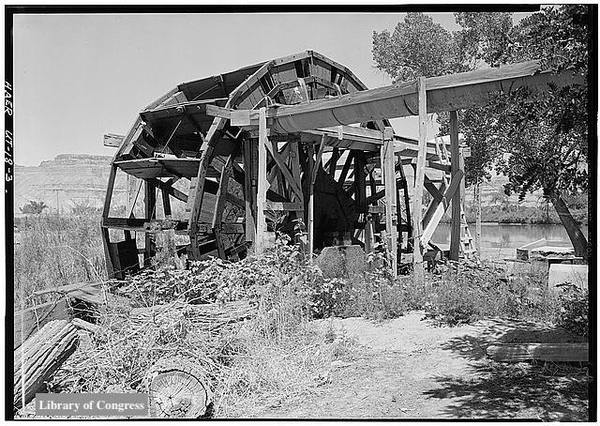Dublin Core
Title
Description
The town of Green River, Utah, is known for its melons. But feeding a thirsty crop takes water, and getting water from the river to the fields takes ingenuity – and engineering.
Just about six miles upstream from the town lies a major reason why the melons in this area are so renowned. Beginning in 1894, local farmers built diversions across the Green River from brush, wood, and rock, in order to push water into irrigation canals that ran on either side of the river. Called the Tusher Dam, this structure was upgraded to concrete in 1934.
In addition to the diversions, Euro-American settlers started building waterwheels on the Green River as early as the 1880s. Waterwheels lifted water out of the river and into the adjoining fields through a series of connected canals and ditches. Using the power of the river current, these early wooden wheels had buckets attached that would fill with water, then be lifted up and dump their load of water into a pipeline or flume.
While most of the waterwheels were replaced by modern pumps, there are two that survive at the Hastings Ranch, right next to the Tusher Dam. A few yards from shore sits the original wheel. It was built in 1940 from lumber and bolts and stands 10 feet wide, 30 feet in diameter, and had 18 wooden buckets to lift the water. What was extra-ingenious about this wheel is that its great height allowed water to be transported to fields upstream. This wheel irrigated about 1,000 acres and operated until 1985. That year, it was replaced by a modern, cutting-edge steel version designed by one of the Hastings Family sons who had gone to work in the aviation industry during World War II. Sadly, the heavy steel wheel never really worked, and it sits on the shore today as an example of how the old ways are sometimes the better way.
While the waterwheels no longer go round and round, the Tusher Dam and its canals are still in use today. And local ingenuity still gets water to those melons!
Creator
Source
_______________
See Historic American Engineering Record, 1971, “Hastings Ranch Irrigation Water Wheel,” UT-18. Department of Interior, on file at Library of Congress, https://www.loc.gov/item/ut0019; National Register of Historic Places nomination forms [draft], on file at the Utah State Historic Preservation Office.

